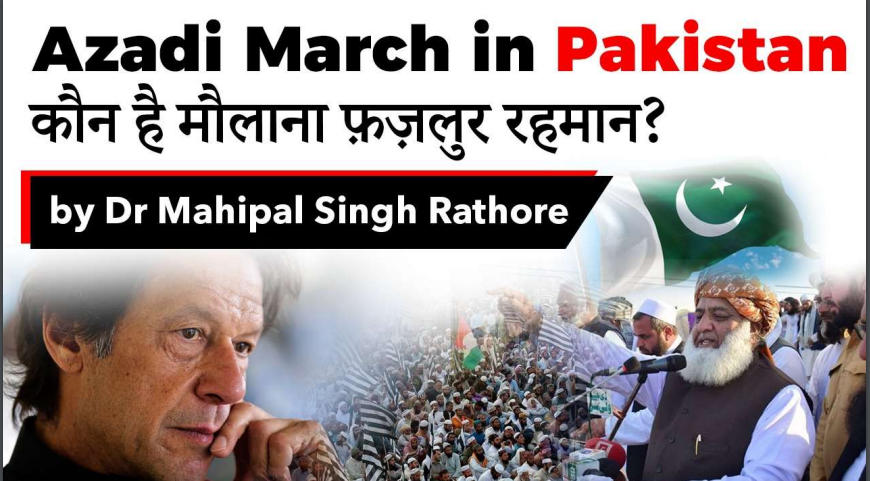Table of Contents

The Azadi March
- The Azadi March is a giant protest rally that began from Karachi on 27th October and made its way through Pakistan, reaching the capital Islamabad on 31st October.
- On 1st November, Maulana Fazl-ur Rehman, gave PM Imran Khan an ultimatum of two days to resign.

- After the expiry of 2-day ultimatum Maulana Rehman has said the protesters will continue the sit-in until their goals are met.
- Pakistan’s Defence Minister Pervez Khattak said that while doors for a dialogue with the opposition were open, “no one should even think about” negotiations on their demand for Imran’s resignation.
- This is the first major challenge to the government since Imran became Prime Minister in a controversial election said to have been manipulated in his favour by the Army in August 2018.
- About 1 lakh protesters have rallied around Fazl-ur Rehman, and have the backing* of major opposition parties.
Why are people protesting?
- Fazl-ur Rehman and his supporters say the 2018 election was unfair, and want Imran to step down.
- They are also angry with the state of Pakistan’s economy, which is currently facing among the worst crises in its history.
- Imran Khan has gone after the opposition leaders since coming to power . This has polarised Pakistan’s polity.



- Fazl-ur Rehman, sometimes referred to in Pakistan as “Maulana Diesel”, is the leader of the Jamiat Ulema-i-Islam (F)
- He is a hardline, rightwing Islamist politician of the kind that often receives significant public support in Pakistan.
- He has led several anti-US and pro-Taliban rallies and demonstrations in Pakistan over the years.
- He belongs to KPK province and has maintained close links with the Afghan Taliban.
- His father was CM of KPK in 1972
- He has long been a operator in Pakistani politics, and has powerful ambitions of his own.
- He was a member of Pakistan’s National Assembly from 1988 to 2018
- Leader of Opposition during 2004-07
- In running for PM in 2002.
- Lost on both his seats in 2018 election
- However, his party, along with other religious parties in a coalition, won 14 seats .
How influential is he?
- His power is the Deobandi madarsas spread all over the country and especially in Khyber Pakhtunkhwa (KP), giving the dharna a distinctly Pashtun flavor.
- Consequently, this dharna consists largely of Madrasa students and the religiously inclined-sections of the lower middle and working classes.
- They face the brunt of the economic downturn and are religiously charged too.
The REAL reasons behind the Long march
- Fazl-ur Rehman’s motives are political – he has always been opposed to Imran.
- PTI has expanded in KPK at the expense of JUI(F)
- Ahead of the elections of 2013, he had declared that voting for Imran’s Pakistan Tehreek-e-Insaf would be ‘haraam’ because Imran, according to him, was an “agent of Americans, Jews, Ahmadiyas, and a person of bad character”.
Gen. Bajwa angle?

- Gen. Qamar Javed Bajwa – Army chief is due to retire at the end of November.
- Imran Khan announced a three year extension of his term.
- The matter has not yet been sealed and signed officially.
- The march could be a pressure tactic by Gen Bajwa, or the manifestation of an internal feud in the military establishment between those who back Imran Khan, and those who do not.
- Lt.Generals who are against an extension to Bajwa?
Why the protest will fail
- No support from upper middle class and influential sections
- Those who are not in favour of a Mullah narrative within the civil society are also not backing the march.
- Not much support amongst the Pakistani Sindhis and Punjabis.
- Biased gender approach – NO WOMEN as a part of march.
What does the Maulana want to achieve?
- Maulana is among the most seasoned and pragmatic leaders in Pakistan and adept in making backroom deals.
- Smart political ploys by him –
- Extending the deadline by a day
- Converting the march into a dharna,
- Calling for an All Party Conference (APC) to decide next steps.
- These steps could include lockdowns, blocking of highways and resignations from assemblies.
Critical time for Pakistan
- Financial Action Task Force (FATF) wants it to take action on the 27-point action plan by February 2020.
- IMF wants implementation of the tough benchmarks that include a substantial increase in taxation.
- Nawaz Sharif’s critical illness.
What can Pak govt do?
- Tire out the crowd by doing nothing and hope they will thin out
- Engage with them
- Use force to disperse them.

Long history of ‘Long Marches’ in Pakistan
- The ‘long march’ – in which an opposition party attempts a non-electoral power grab through street protests.
- In Pakistan’s hybrid military-civilian politics , it is now a permanent feature.
- The government manages to continue in office, but is shaken and weakened.
- 1993 – Benazir Bhutto’s long march. Nawaz Sharif had to resign
- 2009 – Nawaz Sharif led a march against the Yousaf Raza Gillani regime
- 2013- Long March by populist cleric Muhammad Tahirul-Qadri against PPP govt.
- 2014 – Imran Khan joined forces with Tahir-ul-Qadri to bring thousands of protesters to Islamabad against Nawaz Sharif . Reason- Rigged 2013 elections .
- 2017 – March by Tehreek-e-Labbaik Pakistan (TLP)
What is the Pakistani Army’s stand ?
- The Army will have the final word on what happens in Pakistan.
- The last Azadi March in 2014, which was led by Imran khan (who was trying to dislodge Nawaz Sharif from power) had failed to achieve its objective because the Army had chosen not to back him at that moment.
- For all practical purposes the Imran Khan govt is a proxy for the generals.
- It is unlikely that the Army will now allow Imran’s government to be destabilised.
Latest Burning Issues | Free PDF























 WhatsApp
WhatsApp